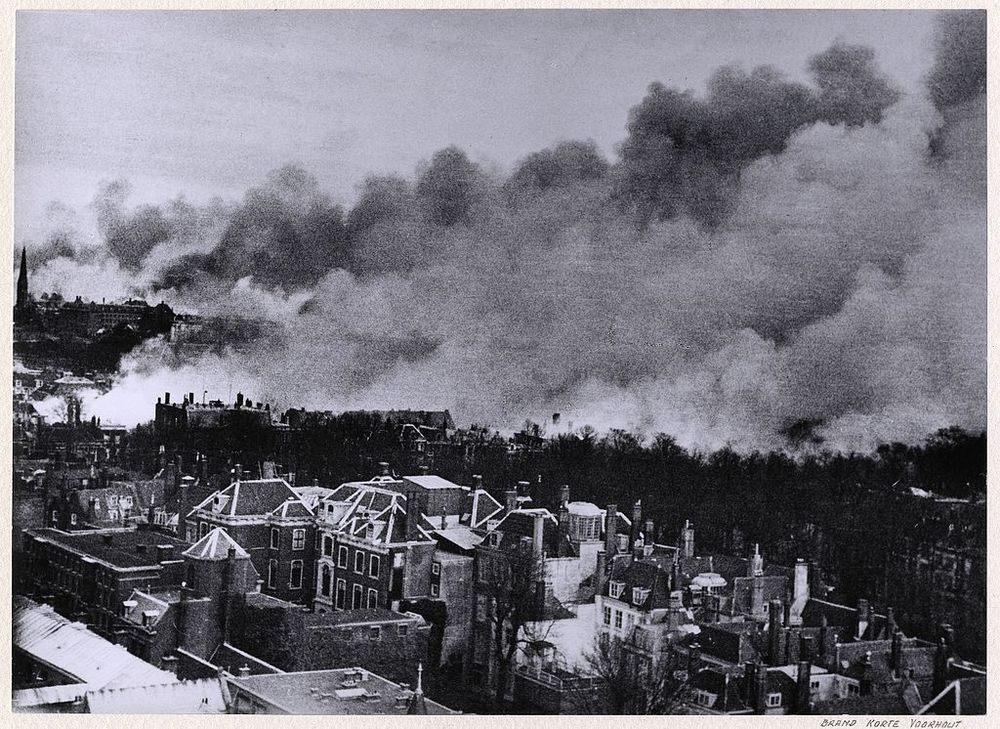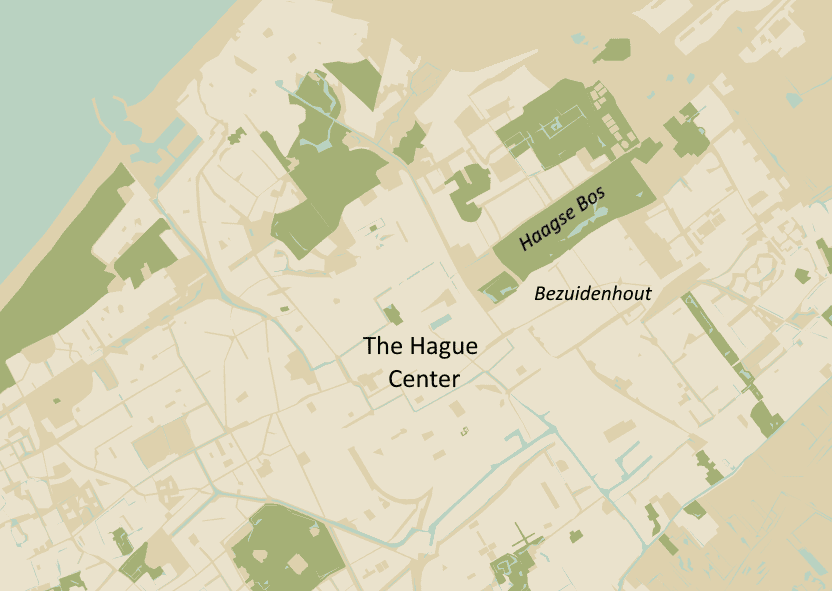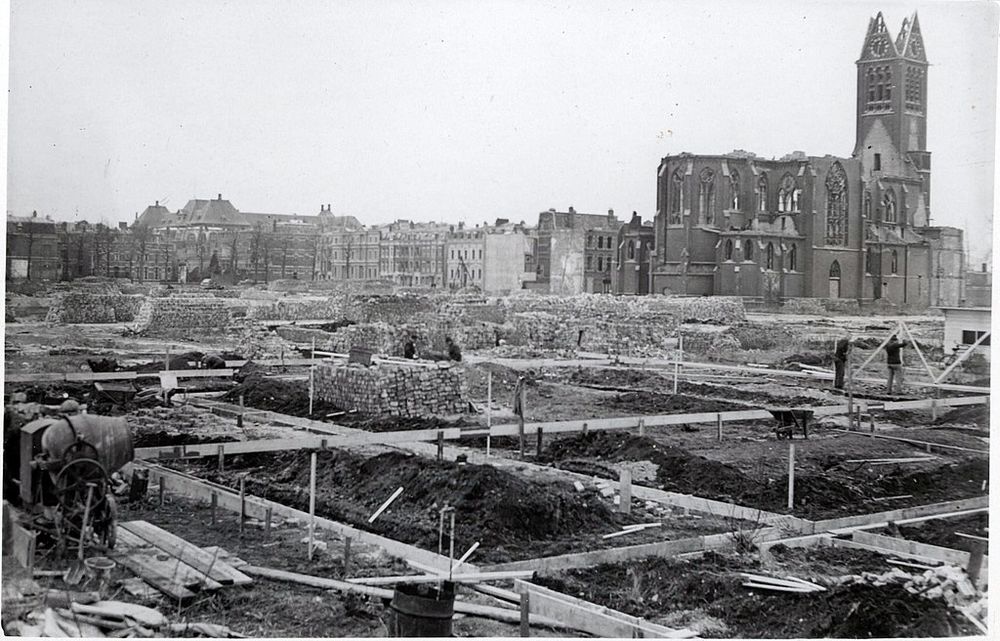At eight o’clock in the morning of 3 March 1945, the air-raid sirens were heard for the first time over Hague. A short while later a wave of bombers appeared over the horizon heading straight towards the city. But instead of bombing the city center, the formation veered to the east and released their bombs over the Bezuidenhout neighborhood. Wave after wave of bombers followed dropping their load on the peaceful city.
“They have lost count. The earth trembles. Buildings and entire blocks collapse like houses of cards collapse. Still others are starting to burn and are soon ablaze,” reported The Telegraph the following day.

The bombing of the Bezuidenhout area on Saturday, March 3rd, 1945. Seen from the tower of the Church of St. James the Greater in Park Street. Photo: Wikimedia Commons
A strong westerly wind picked up the fires caused by the bombing and spread it further across the neighborhood. The fire department was not adequately equipped to handle the fire, and often there was no water to put out the conflagration. Help had to be brought in from South Holland and even from Wormerveer and Zaandam.
More than three thousand buildings were destroyed, five hundred killed and twenty thousand people were rendered homeless. What’s tragic about the devastation in Bezuidenhout was that the perpetrators were not Germans but the Allies.
Early that morning, bombers of the the British Royal Air Force received instruction to bomb the V2 installations in the Haagse Bos, a large forested area inside the Hague that was being used by the Germans as a launch site for their V2 rockets. The V2s were unstoppable. Traveling at supersonic speed and as silently as a hawk, they rained devastation from above, striking at the heart of Britain without warning. Britain had many early warning system installed along its coastline but these could only detect slow moving bombers and fighter planes. No effective defense existed against the fearful V2s.

The Haagse Bos was one of Germany’s primary launch sites, with over a third of all V2 attacks taking place from inside this woods. The bombing of the Haagse Bos was the only way these rocket attacks could be stopped. However, it was difficult to pinpoint the exact location of the V2 installations inside the dense forest, because the launch units were mobile, and it took only half an hour to launch a V2, rearm and then drive to a different launch site.
The British bombers received some approximate coordinates based on information gathered by the British. But human error resulted in one of the coordinates being plotted in the center of Bezuidenhout, located less than a kilometer south of the actual target. To make matter worse, a thick fog enveloped Bezuidenhout and the bombers couldn’t see a thing. Under normal circumstances the pilots would have verified the target by visually locating it, but because of the fog visual sighting was out of the question. The bombers relied on the coordinates supplied and dropped 67 tons of high explosive bombs on the Bezuidenhout area, wreaking widespread destruction.

Bezuidenhout, a neighborhood in the city of The Hague, after the accidental bombing by allied forces. Photo: Wikimedia Commons
By the time the pilots realized their mistakes, it was already too late. Later, the Royal Air Force dropped flyers over Bezuidenhout apologizing for the mistake. Trouw, the Dutch resistance newspaper at the time, wrote the following about the bombings:
The horrors of the war are increasing. We have seen the fires in The Hague after the terrible bombings due to the V2-launching sites. We have seen the column of smoke, drifting to the south and the ordeal of the war has descended upon us in its extended impact. We heard the screaming bombs falling on (the) Bezuidenhout, and the missiles which brought death and misery fell only a hundred metres from us. At the same time we saw the launching and the roaring, flaming V2, holding our breath to see if the launch was successful, if not falling back on the homes of innocent people. It is horrible to see the monsters take off in the middle of the night between the houses, lighting up the skies. One can imagine the terrors that came upon us now that The Hague is a frontline town, bombed continuously for more than ten days. Buildings, burning and smouldering furiously, a town choking from smoke, women and children fleeing, men hauling furniture which they tried to rescue from the chaos. What misery, what distress.
Most tragically, this wasn’t the first time the Dutch were hit by their own allies. On 22 February 1944, Allied bombers were en route to Gotha to reduce a German aircraft factory to ashes. The weather turned bad unexpectedly, and the flyers were instructed to fly to the Dutch city of Nijmegen to bomb a railway station. Unfortunately, most of the flyers were not sure whether Nijmegen was a Dutch or a German city. They were also poorly informed whether German-occupied cities could or could not be bombed, and if so in what way. In the absence of satellite navigation, pilots had to rely upon ground clues to identify their location, which many of the fliers failed to do so. When they unloaded their bombs, many of them believed they were over the German city of Kleve. While the actual target, the train station, was somehow successfully hit, a considerable number of bombs fell on the city center in residential areas, destroying homes, churches and other civil targets and killing eight hundred civilians. In terms of the number of victims, it was one of the largest bombardments of a Dutch city during World War II.

Bezuidenhout, a neighborhood in the city of The Hague, after the accidental bombing by allied forces .Photo: Wikimedia Commons
The Nazis tried to make fun of the Allied debacle by hanging posters in public places that said: “With friends like these, who needs enemies?”.
But the propaganda didn’t work. Seven months later, when American ground troops walked across the Dutch border they were welcomed by the inhabitants.
The bombing of Bezuidenhout is commemorated every year on the first Sunday after 3 March.

Photo: Wikimedia Commons
References:
# Wikipedia
# Inferno In The Hague: British Bombing Residential Bezuidenhout, www.dagvantoen.nl
# BB45



Comments
Post a Comment